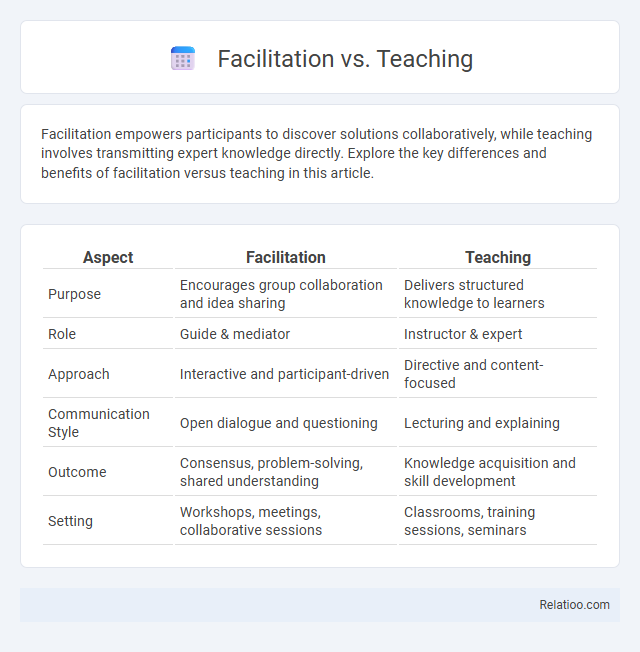Facilitation empowers participants to discover solutions collaboratively, while teaching involves transmitting expert knowledge directly. Explore the key differences and benefits of facilitation versus teaching in this article.
Table of Comparison
| Aspect | Facilitation | Teaching |
|---|---|---|
| Purpose | Encourages group collaboration and idea sharing | Delivers structured knowledge to learners |
| Role | Guide & mediator | Instructor & expert |
| Approach | Interactive and participant-driven | Directive and content-focused |
| Communication Style | Open dialogue and questioning | Lecturing and explaining |
| Outcome | Consensus, problem-solving, shared understanding | Knowledge acquisition and skill development |
| Setting | Workshops, meetings, collaborative sessions | Classrooms, training sessions, seminars |
Understanding Facilitation and Teaching
Facilitation guides Your group's learning by encouraging participation and collaboration, creating an environment where individuals explore ideas and solve problems collectively. Teaching, in contrast, involves delivering structured knowledge and skills from an expert to learners, focusing on content mastery and clear instruction. Understanding facilitation emphasizes empowering group dynamics and shared learning, while teaching centers on authoritative knowledge transfer and direct instruction.
Core Differences Between Facilitation and Teaching
Facilitation centers on guiding group discussions and encouraging collaboration, while teaching involves delivering structured knowledge and information to learners. In facilitation, the facilitator acts as a neutral party supporting idea exchange without imposing content, whereas teaching requires the instructor to provide expertise and direct learning outcomes. The core difference lies in facilitation fostering participatory engagement, whereas teaching emphasizes content transmission and skill development.
Roles and Responsibilities: Facilitators vs Teachers
Facilitators guide group discussions, encourage participation, and help your team co-create solutions without directly imparting knowledge, emphasizing process over content. Teachers deliver structured lessons, transfer knowledge, and assess learning outcomes to ensure comprehension and skill development. Facilitators focus on enabling collaboration and critical thinking, while teachers prioritize curriculum delivery and individual learning progress.
Key Skills Required for Facilitators and Teachers
Facilitators require strong interpersonal communication, active listening, and conflict resolution skills to guide group discussions and foster collaboration effectively. Teachers need deep subject knowledge, curriculum design expertise, and classroom management abilities to deliver structured learning experiences and assess student progress. Both roles benefit from adaptability, empathy, and motivational techniques, but facilitators emphasize process-oriented skills while teachers focus on content delivery and knowledge transfer.
Methods and Approaches in Facilitation and Teaching
Facilitation emphasizes guiding group interactions and fostering collaboration through methods like open-ended questioning, active listening, and consensus-building, enabling participants to co-create knowledge. Teaching typically employs structured approaches such as lectures, demonstrations, and assessments to deliver content systematically and measure understanding. Facilitation blends participatory techniques to empower learners' contributions, while teaching relies on direct instruction and curriculum design to ensure content mastery.
Learner Engagement: Facilitation vs Teaching
Learner engagement in facilitation emphasizes active participation, collaboration, and co-creation of knowledge, fostering a learner-centered environment that values diverse perspectives. In contrast, teaching often involves a more structured, instructor-led approach where engagement arises from guided instruction and direct interaction with the content. Facilitation prioritizes empowering learners to take ownership of their learning process, while teaching focuses on delivering information and ensuring comprehension through targeted methods.
Advantages and Limitations of Facilitation
Facilitation enhances group collaboration by encouraging active participation and fostering diverse perspectives, making it ideal for problem-solving and decision-making processes. Its limitations include reliance on group dynamics, which can stall progress if participants are uncooperative or lack engagement. You benefit from facilitation when seeking to empower your team's creativity and ownership but may require teaching for delivering structured knowledge and clear instructions.
Benefits and Drawbacks of Teaching
Teaching provides structured knowledge transfer and clear learning objectives, making it effective for delivering foundational skills and factual information. Your learning may be limited by the traditional, often passive nature of teaching, which can reduce engagement and critical thinking opportunities. Drawbacks include potential lack of adaptability to individual learning styles and reduced interaction compared to facilitation methods.
Choosing the Right Approach for Learning Outcomes
Choosing the right approach between facilitation, teaching, and coaching depends on the desired learning outcomes and learner engagement levels. Facilitators guide group interactions to foster collaborative problem-solving, teachers deliver structured content for knowledge acquisition, and coaches provide personalized support to enhance skill development. Aligning the approach with specific goals ensures effective learning experiences tailored to individual or group needs.
Future Trends: Blending Facilitation and Teaching
Blending facilitation and teaching is emerging as a future trend in education, incorporating interactive facilitation techniques to enhance traditional teaching methods. This hybrid approach leverages collaborative learning environments and technology to foster deeper engagement and critical thinking among students. Emphasizing adaptability, educators blend facilitation's learner-centered strategies with structured instruction to meet diverse learning needs in digital and hybrid classrooms.

Infographic: Facilitation vs Teaching
 relatioo.com
relatioo.com